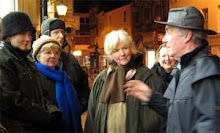

As you approach the ruins of the castle from the village of Corfe, it is difficult not to be in awe of its magnificent and altogether imposing dominance. Built as a fortification, the castle's strategic position was carefully engineered to give advantageous views across the Purbeck Hills, the road from Swanage to Wareham, but most importantly, an uninterrupted view towards the coast.
The castle was constructed approximately 1000 years ago during the rein of William the Conquered and was deemed by its builders to be impregnable. There is evidence that the site had been settled as far back as 4000BC. The Romans had a stronghold here, as did the Celts from around 1300BC. The remains of twelve burial barrows circle the castle, thought to be the tombs of the twelve brides of Celtic chieftains.
During the middle ages it was to become one of five Royal castles. King John is reputed to have kept the Crown Jewels there, along with 22 imprisoned Frenchmen who he had incarcerated in the dungeons but neglected to feed and water them. The distressing sounds of men in their death throws have been heard coming from within the castle walls.
Throughout its history, the castle has been linked to many a pernicious deed. One such story is that of the Anglo-Saxon heir to the throne - Edward the Martyr; who was murdered in AD979, on the orders, it is said of his stepmother - Queen Elfrida, who was determined to see her son Ethelred ‘The Unready’ succeed as King. The story goes, that Edward had just finished a hunting trip when he arrived at the castle gate and was offered a glass of mead. As he drank he was set upon and stabbed in the back. He managed to take flight but shortly afterwards, exhausted and weak through loss of blood slipped from his horse and fell into the stream that runs beside the castle. He was quickly discovered by some of the Queens men and hidden in an abandoned hut. Edwards body was not to remain undiscovered for long, for a search party was dispatched to look for him and find him they did, due, it is said, to a strange shaft of brilliant light that guided party to where Edward lay dying. This miraculous discovery soon spread and the stream where Edward fell was deemed to have spiritual healing properties, especially those struck down by blindness apparently.
Edward was buried in Shaftesbury convent some 30miles away, where the miracles are said to have continued at his tomb, so much so that the convent became a place of pilgrimage. Edward was subsequently canonised in AD1001.
Edwards spectral arrival at Shaftesbury is just one of several ghost stories from the town. Many have claimed over the centuries to have witnessed two phantom figures leading a packhorse with a body draped over its back. They slowly labour up the steep hill that is ‘Gold Hill’ towards Shaftesbury convent, where Edward was finally laid to rest.
The outbreak of the Civil War saw the castle besieged by Cromwell’s army in 1645. Sir John Bankes, the owner of the castle, was a staunch Royalist but had recently died leaving his wife Lady Bankes to gallantly fended off the Parliamentarians assault. No matter what Cromwell’s army threw at Corfe the castle lived up to its impregnability and stood firm. It was only through an act of treachery instigated by Colonel Pitman, one of Lady Bankes employees, that Corfe defences where eventually compromised.
In his desperation, as food was nearly exhausted, Colonel Pitman secretly opened the gate to the enemy and Cromwell’s men stormed the castle. A short battle ensued whereupon the Royalists were defeated. The castle was confiscated then blown up by Cromwell’s engineers. What remains of the castle today is pretty much how Cromwell’s men left it.
It is Lady Bankes ghost that haunts the castle to this day. She is described as being dressed in white, with her head bowed, although some say she appears to be headless but there is no reason why this should be, as she was spared by the Parliamentarians. Her ghost has been seen to walk the castle walls, then glide slowly down the hill to the stream which runs alongside the castles base.
The ghost of a Roundhead has been seen from time to time in the National Trust tearooms and stockroom close to the main gate.
Finally; a legion of Roman soldiers is said to haunt the track that runs down from the Purbeck Hills to the foot of the castle. It is here that the ghostly ‘Army of Purbeck’ marches toward Lulworth and Kimmeridge.






2 comments:
Fascinating read.
Thanks Willow. It's a fascinating place.
Post a Comment